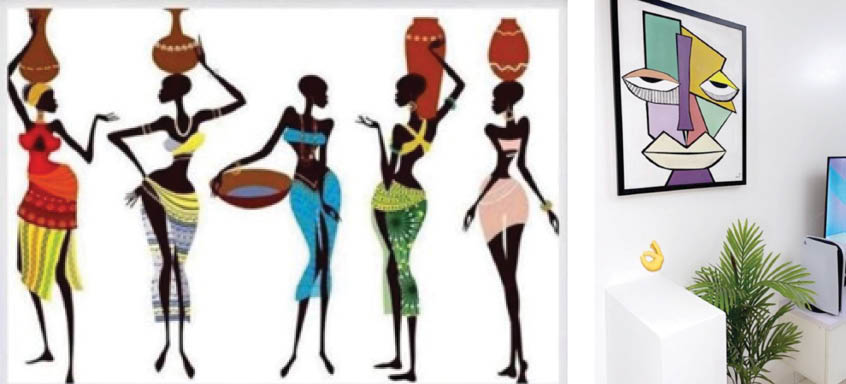Each material has its unique strength – Zona Strings
Echezona Ogudu, aka Zona Strings, is an unconventional artist who makes artworks from the many materials he finds around him, including pins, food, rubber bands etc. In this interview, he shares the reason for his preferred medium of art. What inspired you to start creating art from unconventional materials like Ankara clothing, rubber bands and […]

Art by Tijany
Echezona Ogudu, aka Zona Strings, is an unconventional artist who makes artworks from the many materials he finds around him, including pins, food, rubber bands etc. In this interview, he shares the reason for his preferred medium of art.
What inspired you to start creating art from unconventional materials like Ankara clothing, rubber bands and board pins?
My art is inspired by everyday life and the constant desire to be different.
How do you choose the materials for each of your art pieces? Is there a specific criteria or inspiration behind the selection?
The choice of materials for each piece is influenced by the personality of the subject of the art.
Can you share a specific piece where the choice of unconventional materials played a crucial role in conveying the intended message or theme?
A good example would be the art I made with a whole meal (pasta garnished with carrots, tomatoes, onions, salt, and other food ingredients), recreating the face of Ijele, also known as Flavour Nabania; the popular Nigerian Musician. The idea was to make a visual representation of ‘Flavour’, and as the name implies, all I could think of was food ingredients.
What challenges do you face when working with non-traditional art materials, and how do you overcome them?
Unlike making art with conventional materials such as pencils, paint, and others, the process of making art with these non-traditional materials can be frustrating as one would need a lot of patience and one must have confidence that the work would eventually come out great. One major challenge would be to successfully assemble these materials to create an illusion of realism on the subject (the person’s face, for instance). It is quite difficult. However, I overcame this and other challenges alike by merely studying these materials individually and thinking of them as colours from my palette (like I would in traditional art). This way, it feels like I’m merely working with pencils or paints.
How do you source and acquire the unconventional materials you use in your artwork? Is there a particular place or method you prefer?
These materials are either bought in the market, picked up from trash, or both.
How do you decide on the themes or concepts for your art pieces, and how do the chosen materials contribute to the overall narrative?
Most times, I’m triggered by recent happens in the society, trends, or how I feel about certain subjects that interest me.
Are there specific cultural or personal influences that impact your choice of materials and themes in your artwork?
No specifics, I’m open minded and flexible. Even so, I try not to be offensive in my approach. At the end of the day, I’d like the observer to find something relatable from my artistic orchestration.
Can you walk us through your creative process when working with unconventional materials, from concept development to the final product?
It’s simple. All I need is a thought. And then create the magic in my head, before I eventually start. For instance, I would walk into a market place, and everything I see; from food stuff, to just about anything sold there are like colours on my palette, and when I find one thing that resonates with how I feel at the time, I begin to imagine what they’d look like on my canvas. So, when I pick up my canvas to start, I already have the result I want to see in my head. While I’m on it, I take pictures of the progress stages from time to time, to make sure I’m on track. This might take a few hours or days, but I’m resolved that the art will eventually come out great just like I envisioned.
How important is sustainability in your art practice, considering the use of non-traditional materials? Do you actively seek eco-friendly alternatives?
Sustainability is very crucial in my practice. Hence, I am constantly on the alert for fresh ideas as well as better ways of presentation. But I don’t like to overthink it because it might affect the flow of expression.
Have you ever faced scepticism or criticism for using unconventional materials in your artwork, and how do you respond to such feedback?
Yes I have, but I don’t pay much attention to them, most times I don’t respond to them. But I’m open to constructive criticism, I believe I can learn a thing or two, from good observers.
Are there any artists or art movements that have inspired or influenced your approach to working with unconventional materials?
The art of collage, mixed-media, as well as artists who are exponents of impressionism and abstract expressionism inspire me a lot.
How do you balance the tactile and visual aspects of your artwork when using materials like rubber bands or board pins that have a distinct texture or form?
I take progress shots while working.
Do you experiment with combining different unconventional materials in a single piece, and if so, what challenges and rewards come with that approach?
No, I don’t.
How does the choice of materials affect the longevity and preservation of your artwork? Do you take specific measures to ensure the durability of your pieces?
Each material has its unique strength, and so, to ensure durability I frame some of them with glass, apply resin on some, and I leave some as natural as they are.
Can you share any upcoming projects or ideas where you plan to explore new or even more unconventional materials in your art?
I’d rather not say.
